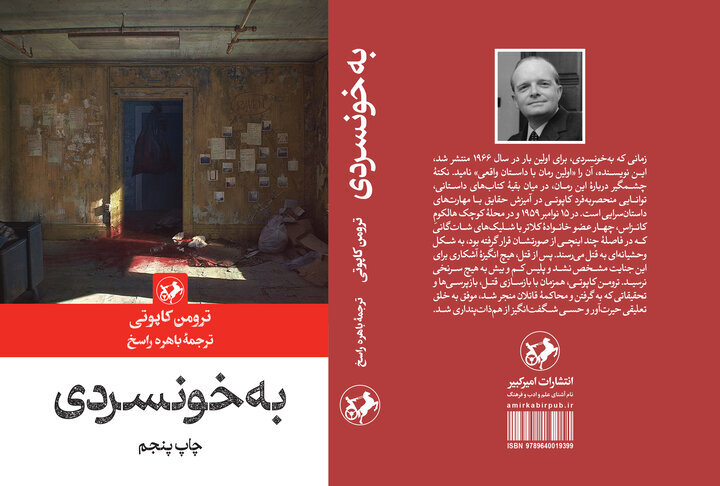Persian edition of In Cold Blood republished
Persian edition of “In Cold Blood” republished
TEHRAN- The 5th edition of the Persian translation of American novelist and screenwriter Truman Capote’s 1966 novel “In Cold Blood” has recently been published.

Amir Kabir Publications in Tehran is the publisher of the book translated by Bahereh Rasekh.
“In Cold Blood” captures the harrowing true story of the Clutter family’s murder in Holcomb, Kansas, in November 1959, blending the lines between journalism and literature in a groundbreaking manner.
Crafted by Capote, the book is often heralded as the epitome of the “New Journalism” genre, a term Capote coined to describe his innovative nonfiction novel approach.
Although other authors had previously ventured into similar territory, Capote's meticulous detail and compelling narrative style have cemented “In Cold Blood” as the quintessential example of this literary form.
The book followed several successful works by Capote and was originally serialized in The New Yorker before its release as a complete novel in 1965. The extensive six-year research and writing process, however, took a personal toll on Capote, ultimately leading him to refrain from publishing additional works following its release.
The narrative revolves around the tragic death of Mr. and Mrs. Clutter and their teenage children, Kenyon and Nancy. In a brutal crime that shocked the small community, the Clutter family was discovered bound and shot in their home, with only minor possessions missing.
Capote became aware of this gruesome event through a report in The New York Times and, intrigued by its shocking nature, travelled to Holcomb even before the killers were apprehended. His research was aided by his friend Harper Lee, who later gained fame for her classic novel, “To Kill a Mockingbird.”
The murderers, Dick Hickock and Perry Smith, initially evade capture, leaving minimal clues behind and displaying no personal ties to the Clutter family.
Throughout the text, Capote delves into their motivations, particularly focusing on Perry's troubled psyche—his feelings of inadequacy, and a tumultuous childhood that bred resentment towards the world. While Dick embodies the image of a criminal outlaw, he too grapples with the heavy impact of their deeds, leaving his motivations shrouded in ambiguity.
The aftermath of the Clutter family’s murder profoundly affects the residents of Holcomb, including Nancy’s close friends and acquaintances. The community struggles to reconcile their perception of the Clutters as the “least likely” murder victims, fostering a pervasive atmosphere of fear and paranoia where trust erodes among neighbors.
Al Dewey, the lead investigator on the case, becomes engrossed in the quest to uncover the truth, allowing the case to consume his life.
As anxiety mounts in Holcomb, Perry and Dick continue their lives with a deceptive sense of freedom, even venturing to Mexico. For a time, it appears they might escape justice altogether.
However, the investigation eventually turns, aided by a living witness and physical evidence that links them to the crime scene, including possessions stolen from the Clutters.
Once apprehended, both men confess their roles in the heinous act. They are tried, convicted, and sentenced to death after several years on death row. Throughout their imprisonment, particularly Perry begins to share his innermost thoughts and motivations, shedding light on the complexities behind his life decisions and the fateful night of the murders.
“In Cold Blood” presents not only a chilling true-crime story but also an in-depth exploration of human psychology, the dark undercurrents of American life, and the profound impact of crime on communities and individuals alike.
SAB/
source: tehrantimes.com